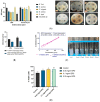Development of Biological Coating from Novel Halophilic Exopolysaccharide Exerting Shelf-Life-Prolonging and Biocontrol Actions for Post-Harvest Applications
- PMID: 38338439
- PMCID: PMC10856335
- DOI: 10.3390/molecules29030695
Development of Biological Coating from Novel Halophilic Exopolysaccharide Exerting Shelf-Life-Prolonging and Biocontrol Actions for Post-Harvest Applications
Abstract
The literature presents the preserving effect of biological coatings developed from various microbial sources. However, the presented work exhibits its uniqueness in the utilization of halophilic exopolysaccharides as food coating material. Moreover, such extremophilic exopolysaccharides are more stable and economical production is possible. Consequently, the aim of the presented research was to develop a coating material from marine exopolysaccharide (EPS). The significant EPS producers having antagonistic attributes against selected phytopathogens were screened from different marine water and soil samples. TSIS01 isolate revealed the maximum antagonism well and EPS production was selected further and characterized as Bacillus tequilensis MS01 by 16S rRNA analysis. EPS production was optimized and deproteinized EPS was assessed for biophysical properties. High performance thin layer chromatography (HPTLC) analysis revealed that EPS was a heteropolymer of glucose, galactose, mannose, and glucuronic acid. Fourier transform infrared spectroscopy, X-ray diffraction, and UV-visible spectra validated the presence of determined sugars. It showed high stability at a wide range of temperatures, pH and incubation time, ≈1.63 × 106 Da molecular weight, intermediate solubility index (48.2 ± 3.12%), low water holding capacity (12.4 ± 1.93%), and pseudoplastic rheologic shear-thinning comparable to xanthan gum. It revealed antimicrobial potential against human pathogens and antioxidants as well as anti-inflammatory potential. The biocontrol assay of EPS against phytopathogens revealed the highest activity against Alternaria solani. The EPS-coated and control tomato fruits were treated with A. solani suspension to check the % disease incidence, which revealed a significant (p < 0.001) decline compared to uncoated controls. Moreover, it revealed shelf-life prolonging action on tomatoes comparable to xanthan gum and higher than chitosan. Consequently, the presented marine EPS was elucidated as a potent coating material to mitigate post-harvest losses.
Keywords: % disease incidence; antagonistic attributes; coating material; marine exopolysaccharide.
Conflict of interest statement
The authors declare no conflict of interest.
Figures
















References
-
- Nadda A.K., Sajna K.V., Sharma S., editors. Microbial Exopolysaccharides as Novel and Significant Biomaterials. Springer International Publishing; Berlin/Heidelberg, Germany: 2021. pp. 2–9.
-
- Pradhan M. Microbial Exopolysaccharides as Novel and Significant Biomaterials. Springer International Publishing; Berlin/Heidelberg, Germany: 2021. Extremophiles: A Versatile Source of Exopolysaccharide; pp. 105–120.
MeSH terms
Substances
LinkOut - more resources
Full Text Sources

